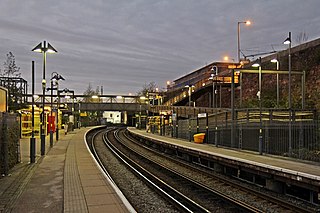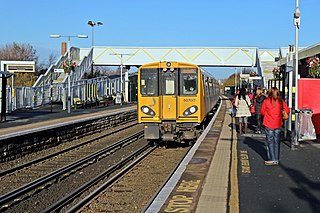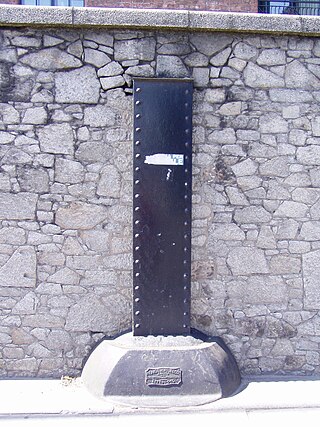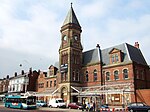
Toxteth is an inner-city area of Liverpool in the historic county of Lancashire and the ceremonial county of Merseyside.

Dingle is an inner city area of Liverpool, Merseyside, England. It is located to the south of the city, bordered by the adjoining districts of Toxteth and Aigburth. At the 2001 Census, the population was recorded at 13,246.

Crown Street Station was a passenger railway terminal station on Crown Street, Liverpool, England. The station was the world's first intercity passenger station, opening in 1830, also being the railway terminal station for Liverpool. Used for passengers for only six years, the station was demolished as the site was converted into a goods yard. The goods yard remained in use until 1972. The location of the station is now a park with little trace of the station or goods yard.

The Port of Liverpool is the enclosed 7.5-mile (12.1 km) dock system that runs from Brunswick Dock in Liverpool to Seaforth Dock, Seaforth, on the east side of the River Mersey and the Birkenhead Docks between Birkenhead and Wallasey on the west side of the river. The port was extended in 2016 by the building of an in-river container terminal at Seaforth Dock, named Liverpool2. The terminal can berth two 14,000 container Post-Panamax ships.

The Liverpool Overhead Railway was an overhead railway in Liverpool which operated along the Liverpool Docks and opened in 1893 with lightweight electric multiple units. The railway had a number of world firsts: it was the first electric elevated railway, the first to use automatic signalling, electric colour light signals and electric multiple units, and was home to one of the first passenger escalators at a railway station. It was the second oldest electric metro in the world, being preceded by the 1890 City and South London Railway.

The Liverpool Overhead Railway Southern Extension Tunnel, also known as the Dingle Extension Tunnel or variations thereof, stretches for half a mile from Herculaneum Dock to Dingle underground railway station, which was the southern terminus of the Liverpool Overhead Railway.

Adlington railway station serves the village of Adlington, near Chorley in Lancashire, England. It is a two-platform station on the Bolton- Chorley- Preston line. This is part of the Northern service link between Preston and Manchester via Bolton and Chorley.

Brunswick railway station serves the Toxteth district of Liverpool, England, on the Northern Line of the Merseyrail network. The station serves the nearby district of Dingle and is situated on a short section of track between two tunnels, between the now in-filled Toxteth and Harrington Docks. The station also serves businesses on the Brunswick Dock estate. The residential area of Grafton Street is reached by steps or ramp from the southbound platform.

Exhibition Centre railway station, previously called Finnieston (1979–1986) and Stobcross (1894–1959) due to its location in the Stobcross area of the city, is a railway station in Glasgow on the Argyle Line. It serves the OVO Hydro, the SEC Centre and the SEC Armadillo which are accessible by adjoining footbridge from an island platform. The station suffers badly from congestion at concerts as most of Greater Glasgow can be reached from the station. There is a siding adjacent to Platform 2, that can be used as a turnback siding for trains terminating at Anderston or Glasgow Central Low Level. The line is served by Class 318s and Class 320s. Ticket gates are in operation.

Port Glasgow railway station is on the Inverclyde Line, serving the town of Port Glasgow, Scotland. It is located in the town centre with the main entrance at the junction of Princes Street and John Wood Street.

Aintree railway station is a railway station that serves the village of Aintree, Merseyside, England. It is on the Ormskirk branch of the Merseyrail network's Northern Line. Until 1968 it was known as Aintree Sefton Arms after a nearby public house. The station's design reflects that it is the closest station to Aintree Racecourse, where the annual Grand National horse race takes place.

Seaforth Sands was a terminus station located on the Liverpool Overhead Railway at Seaforth, west of Crosby Road South, Knowsley Road and Rimrose Road junctions.
Spellow railway station was located on County Road, Walton in Liverpool, England.

Breck Road railway station was located on the Canada Dock Branch to the north of Townsend Lane between Anfield and Clubmoor, Liverpool, England. It opened on 1 July 1870 and closed on 31 May 1948.

Alexandra Dock railway station was located on the Alexandra Dock Branch, in Liverpool, England. The station served Alexandra Dock until the last train on 31 May 1948. Formal closure followed on 26 February 1949.
Mauchline railway station was a railway station serving the town of Mauchline, East Ayrshire, Scotland. The station was originally part of the Glasgow, Paisley, Kilmarnock and Ayr Railway.

Altcar Rifle Range railway station was a railway station on the Liverpool, Crosby and Southport Railway, situated a third of a mile north of Hightown, Merseyside.
Toxteth Dock railway station was on the Liverpool Overhead Railway, adjacent to the dock of the same name and the Brunswick Goods station on the Cheshire Lines railway, England. It was situated above a London Midland & Scottish goods railway station.

Wapping Dock railway station was on the Liverpool Overhead Railway, adjacent to the dock of the same name. It was primarily used for access to the large warehouses nearby.

Herculaneum Dock railway station was the original southern terminus for the Liverpool Overhead Railway. Actually adjacent to Harrington Dock it was named after Herculaneum Dock, a somewhat larger dock beyond the end of the line. It was opened on 6 March 1893 by the Marquis of Salisbury.






















